Numerous inventions of the 19th - early 20th centuries radically changed ...

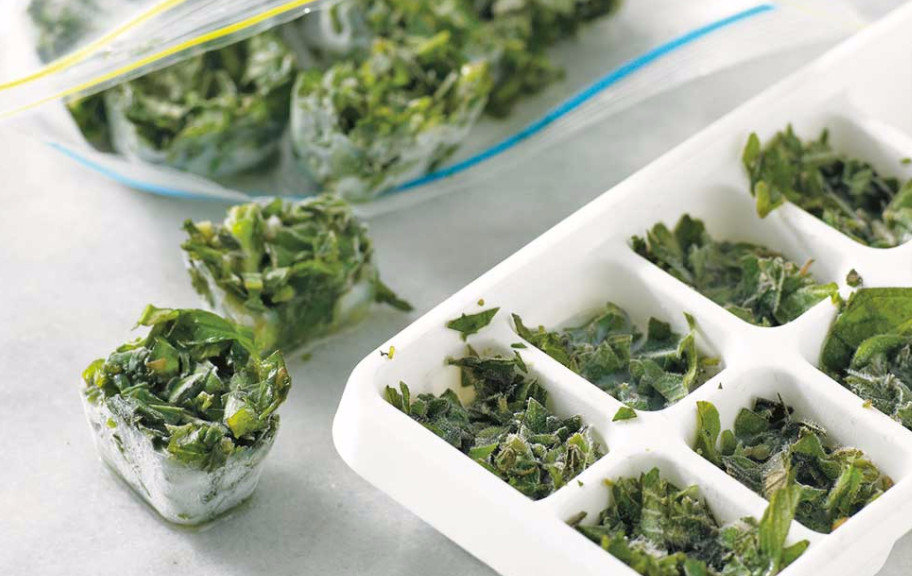
At home.
Perhaps, it is best suited for such a storage method as freezing. After all, it is it that allows you to save most of the valuable substances included in plants. And greens are very useful for the human body, and nutritionists everywhere recommend introducing it into the daily diet. So, for example, it contains up to 25% of the daily iron requirement for the human body, and contains four times more vitamin C than, for example,.
Did you know? in the open air it is able to withstand winter cold - up to minus 5-7 ° С.
However, not all greens can be frozen. So, do not recommend freezing as it becomes watery. In addition, it changes its taste and attractive appearance. Although culinary experts say that there are several recipes that can be used to avoid this problem. For example, add a plant to dishes in an unfrozen form, or freeze with or.
Many are interested in whether it is possible to freeze the leaves for the winter. This should not be done either. After defrosting, it turns into an unattractive porridge that no longer has a fresh taste or smell.
Freezing is also not advised. If there is a need to preserve it for the winter, it is better to use drying. This will keep the flavor better. 
For soup, frozen ones are perfect. They can be frozen individually or as a mix.
Important! To avoid the loss of nutrients during heat treatment, and must be added at the end of cooking, when it has already been removed from the stove.
To decorate dishes, you can freeze curly and ordinary,. Also, greens are frozen for filling in savory pies. For this purpose, and are well suited.
If you plan to freeze the green mass in bunches, then you will need to remove the stalks. When freezing in other ways, the greens will need to be finely chopped using a sharp knife or scissors.
Also, some plants recommend blanching before freezing. In the case of greens, this means scalding with boiling water. It is important to understand that during this process, some of the vitamins disappear and the smell weakens somewhat.
Important! The less time passes from the process of collecting herbs to freezing, the more vitamins will remain in the plants..
There are several ways to freeze fresh herbs for the winter. They must be selected depending on where you plan to use it in the future.
In order not to bother much, the green mass can be frozen in its entirety in bunches. Here's how to do it:
To use, you will need to remove the "sausage" from the freezer, open it from one end and cut the required amount of greens. Pack the rest and place back in the freezer. In case of accidental violation of the integrity of the film or foil - wrap with a new layer.
You can freeze any greens in bunches. In this form, it can be used in salads, first courses, side dishes, pies, sauces, pizza. 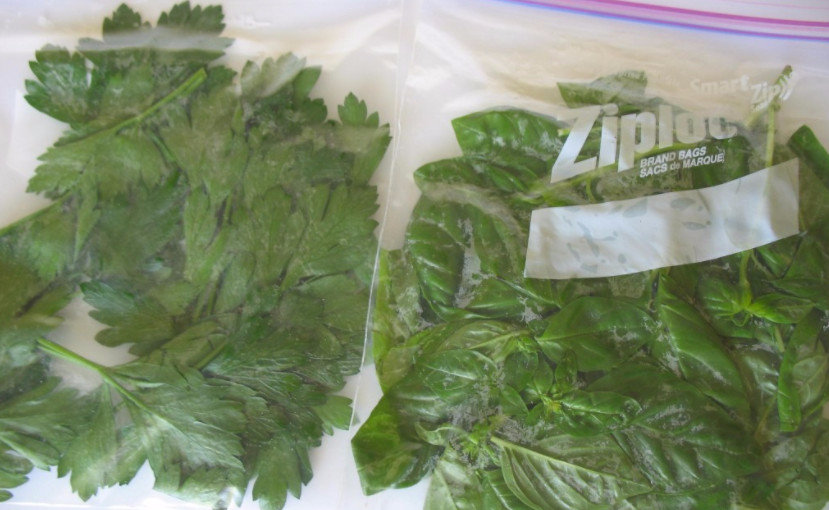 There is also a way to store greens in bags and containers:
There is also a way to store greens in bags and containers:
The green seasoning prepared in this way is removed from the freezer immediately before being placed in the finished dish and, without defrosting, cut, and then added to food.
Using the freezing method, you can prepare for the winter,,.
If you have time, then all the grass that you plan to freeze will need to be chopped.
Sliced plants are frozen in this way:
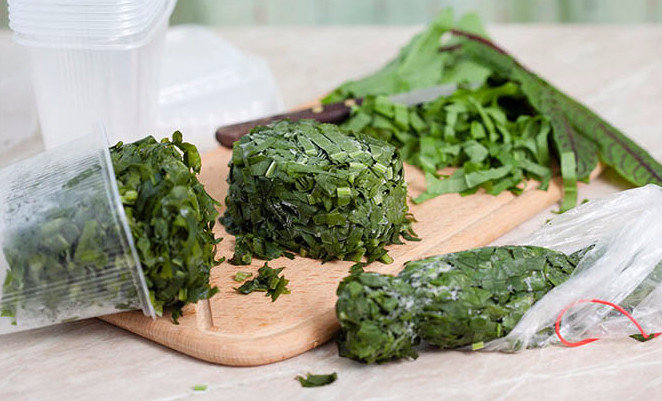 So you can freeze one type of grass or several. Preferably in small batches.
So you can freeze one type of grass or several. Preferably in small batches. There is another way to freeze cut plants:
To always have fresh herbs on hand, you can grow spicy herbs (,,) on the windowsill.
Few people know how to freeze greens in the freezer with cubes. However, this is a simple matter and not at all troublesome. Here's what the process looks like in practice:
Cubes can continue to be stored in the ice tray. And after freezing, you can take them out and pour them into one container or bag. 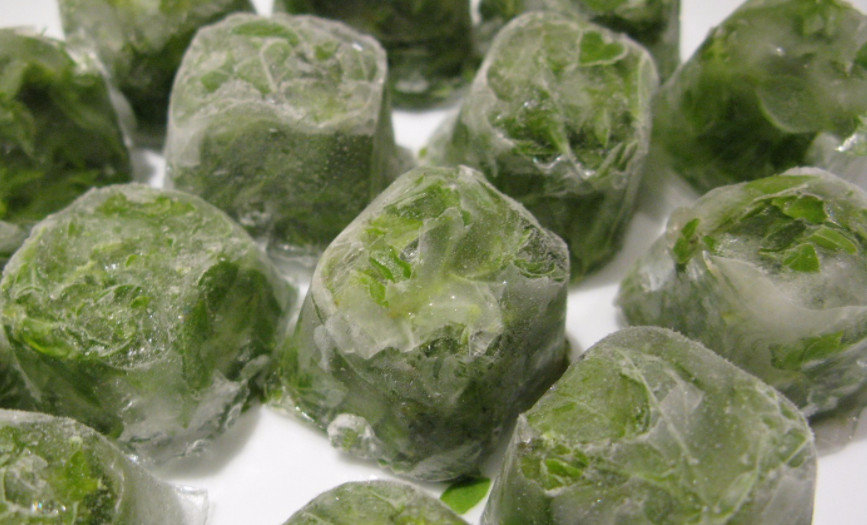 Cubes are also great for freezing herbs for tea. To do this, they are first brewed in a teapot, and then, after the tea has cooled, it is poured into ice molds. After freezing, it is good to add such cubes for a herbal taste to ordinary hot tea or simply to boiled water. They are also used to wipe the face with various skin problems, or for toning.
Cubes are also great for freezing herbs for tea. To do this, they are first brewed in a teapot, and then, after the tea has cooled, it is poured into ice molds. After freezing, it is good to add such cubes for a herbal taste to ordinary hot tea or simply to boiled water. They are also used to wipe the face with various skin problems, or for toning.
Did you know? At first, the inhabitants of Ancient Greece and Rome did not eat, but decorated their homes with it and prepared medicinal potions from it.
Frozen herbs are usable for one year after freezing. In the future, they will lose more of their valuable substances and remain tasty, but useless for the body. 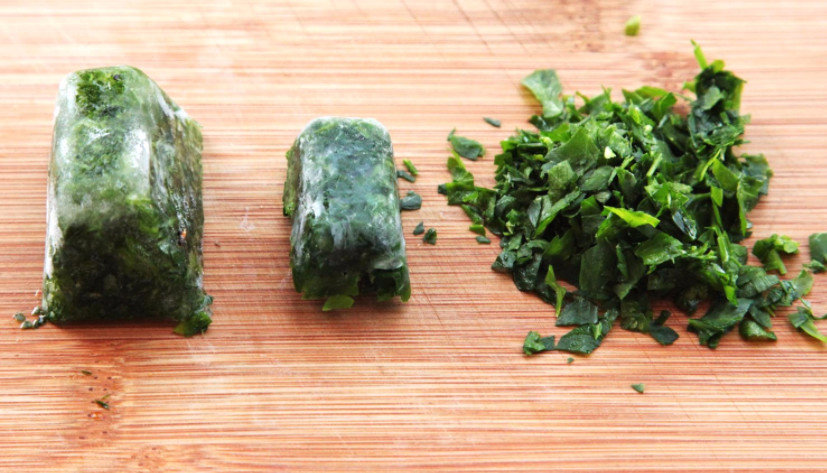
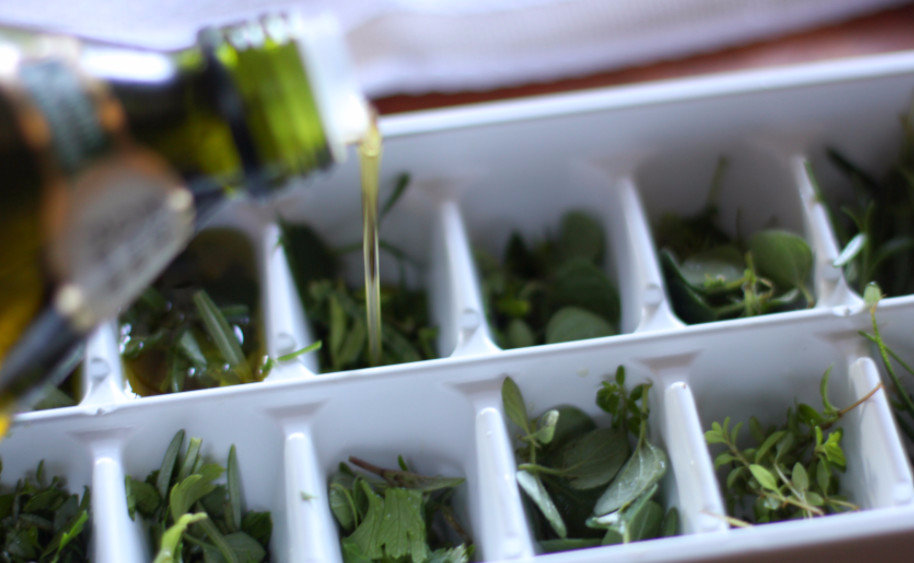 Freezing is one of the easiest and cheapest ways to prepare food for a long time. Using one of the recipes for freezing greens for the winter given by us above, you can winter period replenish your body with the necessary vitamins and minerals contained in delicious and fragrant dishes.
Freezing is one of the easiest and cheapest ways to prepare food for a long time. Using one of the recipes for freezing greens for the winter given by us above, you can winter period replenish your body with the necessary vitamins and minerals contained in delicious and fragrant dishes. Was this article helpful?
Not really
Freezing greens for the winter allows you to use a fresh product all year long, getting valuable vitamins during a period of decreasing vitality of the body. In addition, it is convenient, and most importantly, quickly. Any greens when frozen will not lose their color or useful properties and aroma.
The most effective and economical way is freezing in vacuum bags. Even if you bought parsley and it looks perfect, you still need to sort out the greens, wash and remove the cuttings, which, by the way, we don’t throw away, since they can also be frozen separately and boiled broths with them. So how to freeze parsley for the winter:
You can wash the greens by soaking for a couple of minutes in cold water, if there is a little earth. After washing, let the greens drain in a colander, and lay it on a towel so that it dries completely (about 1-2 hours), periodically stirring and shaking the bunches. After drying, we lay out the parsley in dry bags in bunches or already chopped, press it, releasing all the air, and tie the bag onto the knot if it is without a special fastener. Ready! Greens can be stored in the freezer all year, until the next harvest.
Many people think that it is impossible to prepare a salad for the winter, because after freezing it is no longer so tasty, and it loses its shape, becomes lethargic, and can break apart. But there is a way in which lettuce leaves will be like fresh from the garden - this is freezing in foil. Lettuce is washed and dried, like parsley. And wrapped in a sheet of foil, it can be sent to winter in the freezer.
For freezing, only young bean shoots of pale green color are selected so that the pod can be “cut” with a fingernail. The pods are thoroughly washed in cold water, the stalks are cut off and laid out on a towel to dry. Dried beans can be cut into pieces convenient for cooking, or you can send them whole in bags and in the freezer. Be sure to remove excess air from bags before freezing.
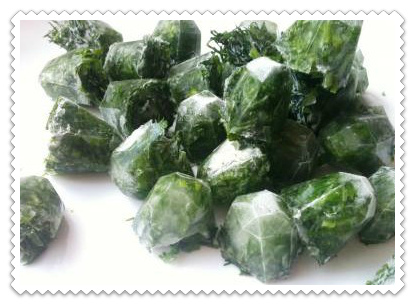 Harvesting broccoli is recommended to be done in the middle of summer, at the very height of the season. The product should have dense, bright green buds that have not yet begun to turn yellow, split or have painful brown spots. So, we are learning how to freeze broccoli for the winter correctly:
Harvesting broccoli is recommended to be done in the middle of summer, at the very height of the season. The product should have dense, bright green buds that have not yet begun to turn yellow, split or have painful brown spots. So, we are learning how to freeze broccoli for the winter correctly:
Broccoli is well washed from dirt. To get rid of small insects, you can soak the product in saline solution (4 teaspoons of salt per liter of water) for 30 minutes. After that, all leaves, a hard stem are removed from it and divided into separate inflorescences. Now broccoli is blanched in boiling water for about 3 minutes (you can over steam, then 5 minutes).
It remains to rinse the cabbage in cold water and let its inflorescences dry. Now broccoli can be sent to the freezer, laid out in sealed bags.
For freezing rhubarb for the winter, dense young and juicy stems of bright color, preferably with a minimum of fibers, are suitable. Leaves are separated from the stems and washed in running water. After that, the coarse upper fibers are cut off and, if necessary, the rhubarb is cut into pieces that are convenient in size for cooking. The finished dried product is laid out in plastic bags or plastic containers, and sent to the freezer for the whole winter.
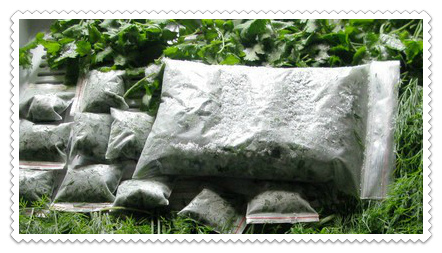 When freezing basil for the winter, it retains all the useful essential oils. The first step is to get fresh basil with soft stems. The bundles are washed in running water, dried and disposed of the stems.
When freezing basil for the winter, it retains all the useful essential oils. The first step is to get fresh basil with soft stems. The bundles are washed in running water, dried and disposed of the stems.
After or while chopping with a knife or blender (but not into a puree powder), the basil is sprinkled with olive oil, which will prevent the product from darkening when frozen and give a more piquant taste, although this is not necessary. Prepared basil is laid out in containers or sealed bags and sent to the freezer.
Now, our dear hostesses will have no questions left about how to freeze greens for the winter - all this is as easy as shelling pears. Take action!
SHARE THE RECIPE:Many housewives have long adapted to freeze berries, tomatoes, and peppers. But undeservedly, lettuce is forgotten, it can also be frozen. Such blanks are very helpful in winter, save time and family budget.
Useful material
We will now tell you how to freeze a salad for the winter, but first we will say a few words about its benefits. There are a lot of varieties of lettuce. These are small-leaved and headed species. What unites them is a high content of microelements and vitamins.
Lettuce leaves are high in vitamin C, A, D and group B. Metabolism is disturbed or the heart rhythm is lost, these symptoms indicate that the body is getting enough potassium. The content of this substance in the salad is more than 38%. Calcium provides bone strength and tooth enamel strength. In lettuce leaves it is 15%. Sulfur, which is part of hemoglobin, is also found in lettuce.
The leader in iodine content is watercress. And, as you know, it is with a lack of iodine that diseases of the thyroid gland develop, fatigue increases, and mental abilities decrease. Only 50 grams of lettuce, and the daily need for iodine will be satisfied.
Magnesium is able to protect against stress and has a positive effect on the nervous system. Iron is also found in lettuce leaves. Metabolism, the process of blood renewal cannot do without this substance. Helps strengthen the immune system.
Some types of lettuce contain bitterness and resins, they have anti-cold and diuretic effects, and help improve appetite.
Salad like vegetable crop useful at any age. It is able to get rid of obesity, prevent atherosclerosis, hypertension and normalize blood cholesterol levels.
Freezing preparation
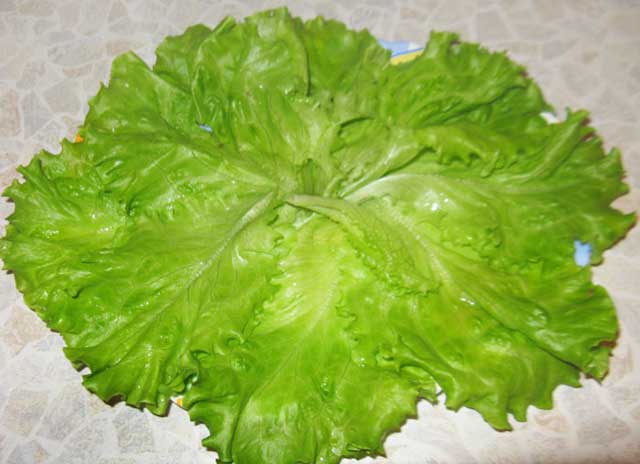
Many varieties of lettuce are used for freezing, the main thing is to prevent the start of shooting. Leaves are selected, without damage. Since the lettuce grows close to the ground, it is washed thoroughly, the water is changed and washed under running water. After that, the salad is laid out to dry.
So, how to freeze a salad for the winter and what you need for this
Packaging
All types of food containers, bags and even foil will fit for packaging. Wide leaves are folded into it, after which they are tightly wrapped so that the leaves do not change their shape. Lettuce for freezing is better not to cut. But you can make salad puree by chopping it with a blender.
Freezing in the freezer
The packaged salad is placed in a freezer and frozen at a temperature of minus 18. With such a freezing, the product is stored for 8-11 months, and at a temperature of minus 1-8 no more than three months. The fresher the salad is, the better it will keep and will not lose its appearance after defrosting.
How to use frozen lettuce?
Most often, lettuce leaves are not used as an independent dish, but added to soups, scrambled eggs, sauces. For them, mashed salad greens are suitable. In various stews, sauté, dressings, frozen lettuce leaves are also used.
Now, knowing how to freeze green salad for the winter, do not miss the freezing time. By the way, you can.
Many of us are accustomed to harvesting greens for the winter. Of course, the most widespread way of harvesting herbs is to dry them.
This method has been well known for centuries and is still popular today. However, drying greens is a rather long process. Yes, and our grass loses its beautiful color with this method. Therefore, we recommend that you freeze the greens. And how to do it, read on.
For freezing parsley, vacuum bags are best, which we should stock up on in advance. Next, take the parsley. This herb is famous for its versatility. This is manifested, first of all, in the fact that the stems and leaves of parsley are used to prepare various dishes. For example, the leaves go to salads and main dishes, but the stalks can make a fragrant broth.
Wash the parsley and cut off the leaves from the stems. Dry the herbs by spreading them on paper towels. Dried greens can be cut, or you can freeze straight whole. We lay out the parsley in vacuum bags, release the air and send the bags to the freezer.
Asparagus beans should be pre-prepared. We cut off the stalks from it and wash it well. Dry on paper or cloth towels. Next, we lay out the beans in bags, let out the air and send it to the freezer for freezing.
For freezing, we take only rhubarb leaves. Rinse them with water and dry thoroughly. Next, you can cut our leaves into pieces to make it easier to use in the future. We lay out the greens in plastic bags and remove for freezing.
We freeze only basil leaves. We separate them from the stems, wash and dry. Next, grind the basil leaves, but not very finely. You can drizzle them with a little olive oil. This will help the greens retain their natural color. We pack all the greens in bags. We freeze.